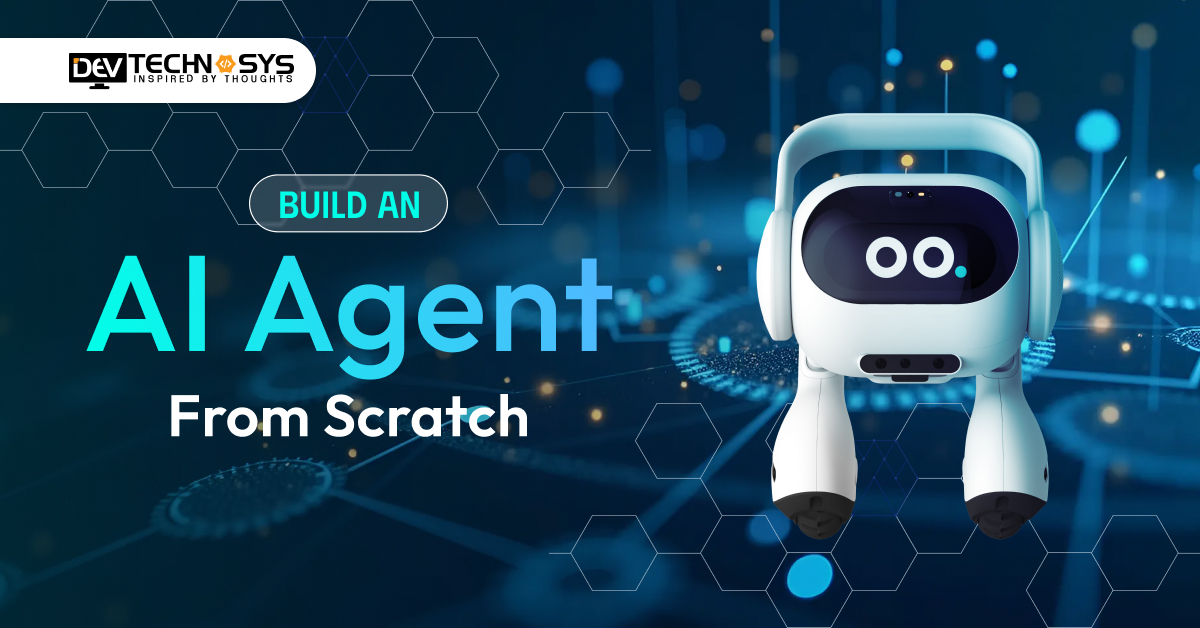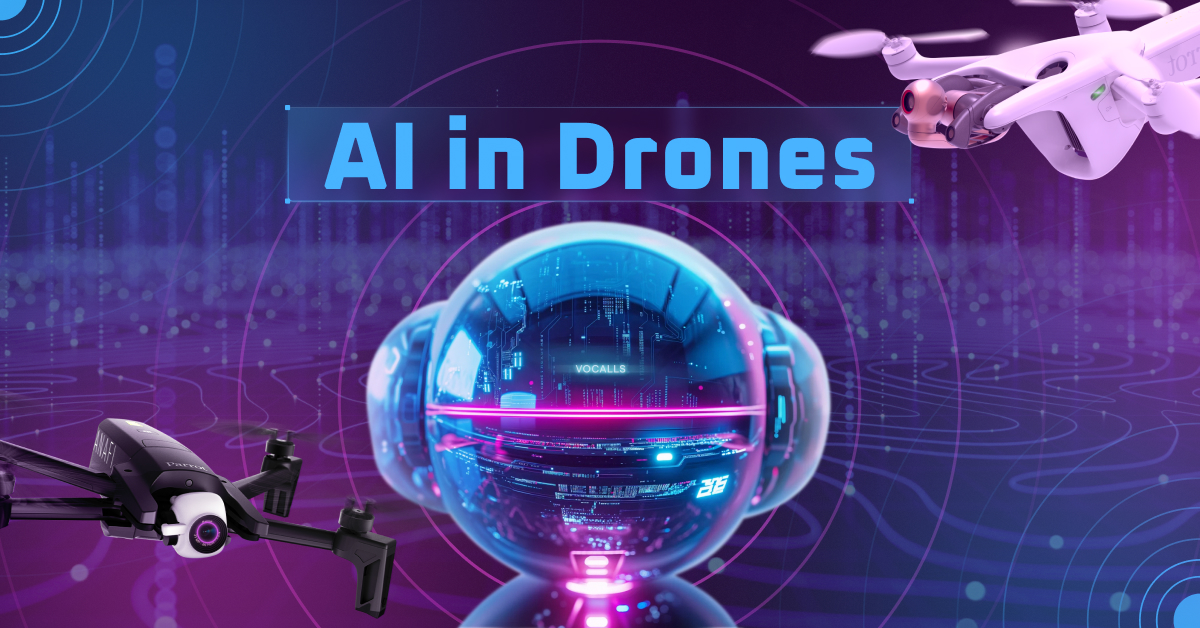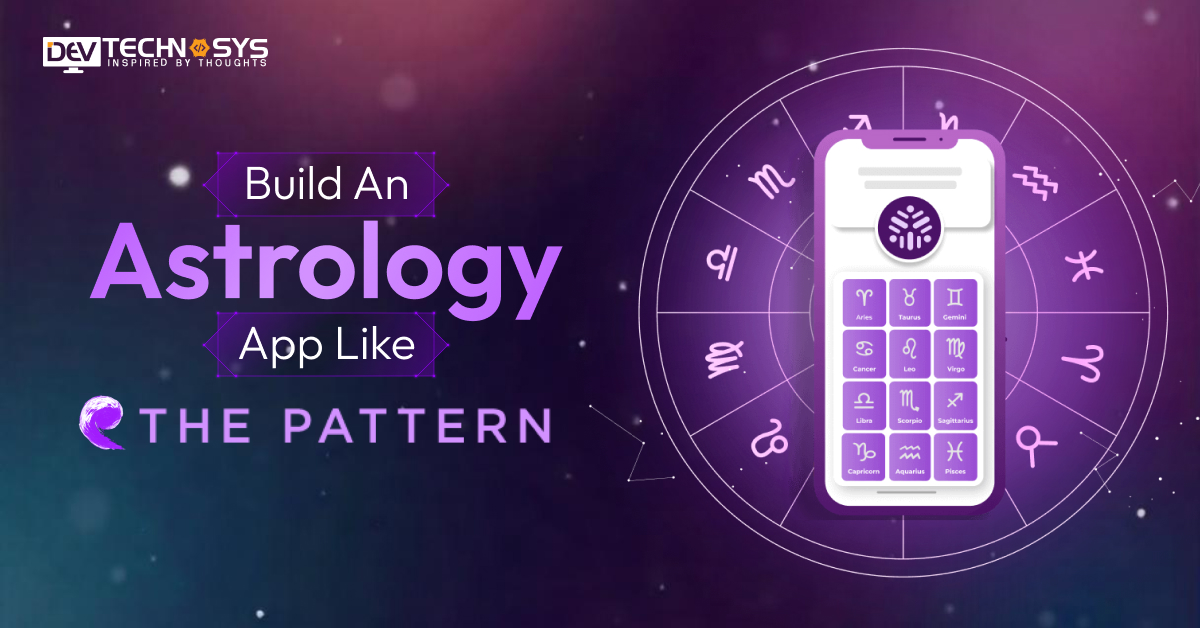Ever wished you had a virtual assistant that could handle repetitive tasks, make wise decisions, and respond like a pro—all without needing constant input? That’s exactly what AI agents do. From automating customer queries to optimizing workflows, these smart AI systems are becoming an essential part of software development.
As we know, the global AI agent market is booming rapidly, thanks to the rapidly growing demand and advancements in AI technology, and it is expected to rise even higher in the coming years. If you are an entrepreneur looking for an opportunity to start your journey with AI agents, Now is the time!
However, building an AI agent is not as simple as you think; there’s a lot that is needed to develop an AI agent from the ground up. To develop an AI agent, you need to follow various steps. But before learning how to build an AI agent from scratch, let’s learn a bit more about what an AI agent knows about their types, features, and other crucial factors. So, keep reading!
What are AI Agents?
An AI agent is a computer program made specifically to help people by answering questions and performing various tasks. The main agenda to create own AI agent is to help people. Artificial intelligence (AI) agents streamline everyday tasks for users, like managing emails and making appointments, by learning from various language inputs.
These Agents handle tasks like schedule management and reminder set-ups to provide information like weather updates or news. The programming of these AI agents is done in a way that enables them to understand and respond to human language. It makes communicating with them more natural and user-friendly.
Market Overview of AI Agents
- The global AI agents market size and share is projected to increase from USD 5.29 billion in 2024 to USD 216.8 billion by 2035, representing a CAGR of 40.15%, during the forecast period 2024-2035.
- Among these categories, the single-agent segment growth is expected to be the maximum, capturing a market share of 74.34% by 2035.
- The machine learning segment will augment the growth with a market share of 77.65% by 2035.
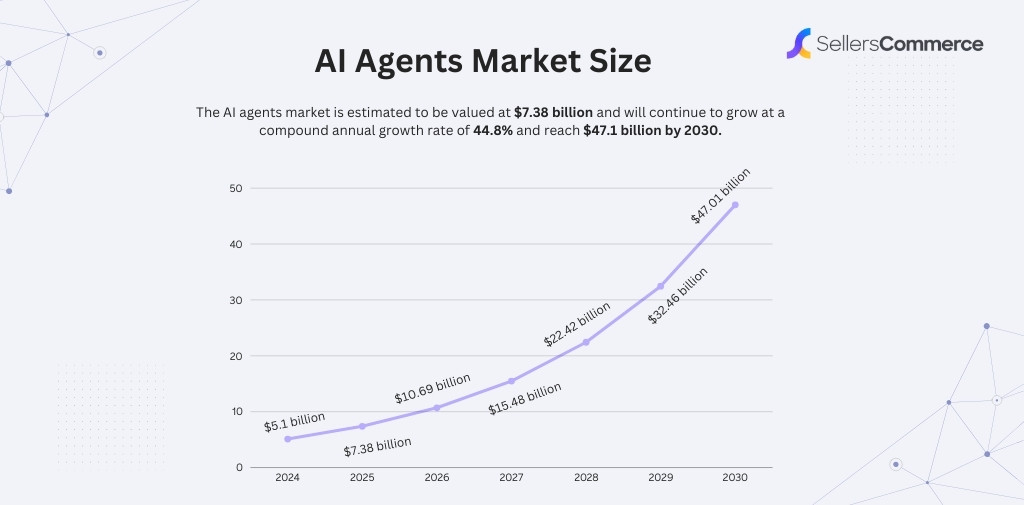
- 88% Of Organizations Are Either Exploring Or Piloting AI Agents
- The AI agents market is expected to rise from USD 7.84 billion in 2025 to USD 52.62 billion by 2030 at a CAGR of 46.3% during the forecast period.
Understanding The Basics of Building and Training AI Agents
Proper training is necessary to develop an AI agent, especially to make them understand and respond to human language in a useful and relevant manner.
The data you provide is the core, whether it’s generative AI (GenAI) or conversational AI. Training incorporates various AI concepts, including machine learning and natural language processing (NLP). Let’s review it separately.
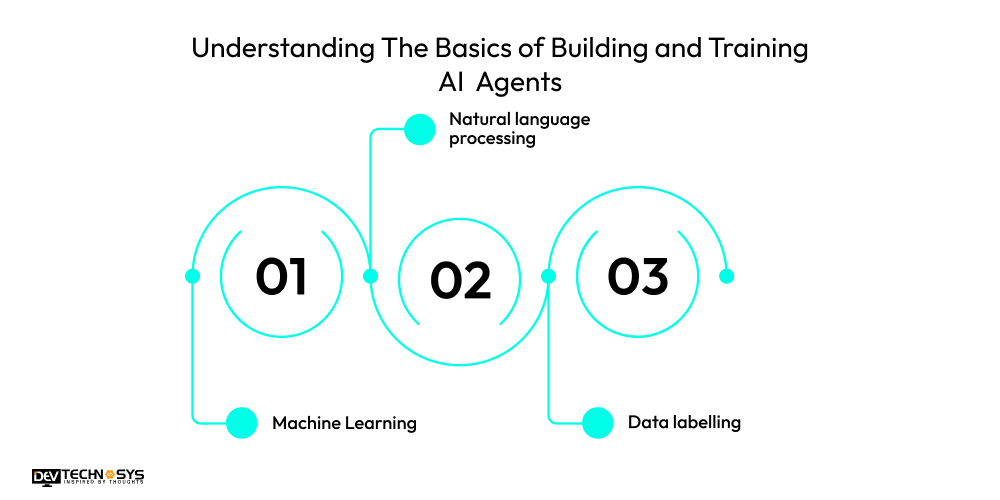
1. Machine Learning
To successfully make an AI agent, concepts like machine learning play an important role. Machine Learning is the concept of AI that helps systems automatically understand and improve from experience, even if they are not programmed.
According to experts who provide machine learning development services, when training an AI agent, machine learning algorithms utilize historical data, like examples of human interactions, to identify any patterns and make informed decisions. AI gets better at making predictions and responding to user requests with the amount of data it processes.
2. Natural language processing
Natural language processing (NLP) is a subsidiary that handles interaction between computers and humans through NLP. To build AI agents from scratch with no code, they use concepts like NLPs.
The main purpose of it is to make computers process and understand vast amounts of natural language data. In terms of building an AI agent, NLP not only lets systems understand but also interprets and generates human language that seems natural and makes sense.
3. Data labelling
Data labeling is one of the crucial concepts in training AI, where humans deliver data by incorporating meaningful tags or labels in the raw data, enabling AIs to understand it.
For example, when providing chatbot development services or training an AI agent, data labeling might incorporate tagging parts of speech in sentences, understanding the intent of the text or sentence, or placing queries into various topics.
This tagged data acts as a guide for the AI to learn from and use these labels to recognize the intent and context behind user inputs. Take note of this concept when you create an AI agent from the start.
Top 10 AI Agents You Can Explore In 2025
Here are the top 10 AI agents you can explore in 2025. Have a look:
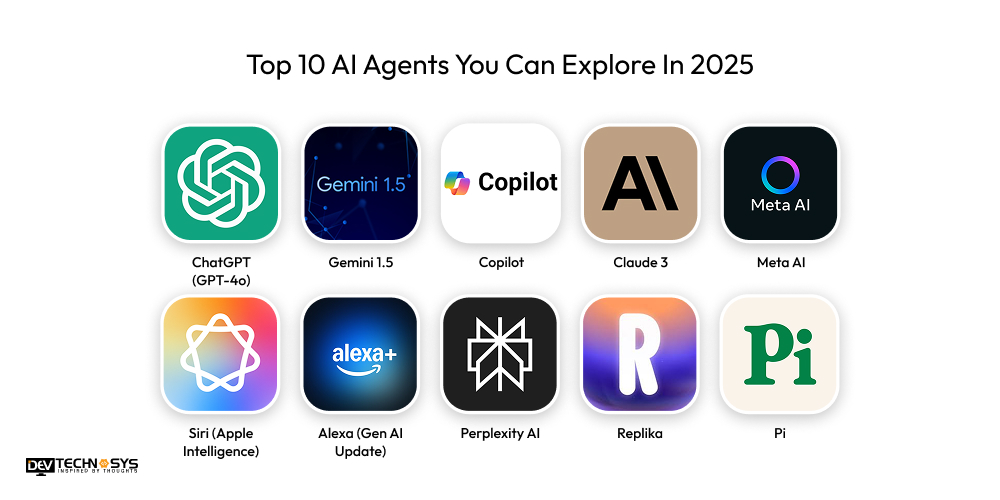
AI Agent |
Developer / Company |
Primary Use Case |
Platform Availability |
| ChatGPT (GPT-4o) | OpenAI | General-purpose AI assistant | Web, iOS, Android, API |
| Gemini 1.5 | Google DeepMind | Research, productivity, code generation | Web, Android, Workspace |
| Copilot | Microsoft + OpenAI | Coding, writing, productivity | Windows, GitHub, Office Suite |
| Claude 3 | Anthropic | Natural language, research, summaries | Web, API |
| Meta AI | Meta (Facebook) | Social media integration, search, chat | Instagram, WhatsApp, Facebook |
| Siri (Apple Intelligence) | Apple | Voice assistant, on-device AI | iOS, macOS |
| Alexa (Gen AI Update) | Amazon | Smart home, voice commands, shopping | Echo Devices, iOS, Android |
| Perplexity AI | Perplexity AI Inc. | AI-powered search and question answering | Web, iOS, Android |
| Replika | Luka, Inc. | AI chatbot for companionship | iOS, Android, Web |
| Pi | Inflection AI | Personal AI assistant, emotional support | Web, iOS |
Types of AI Agents
Businesses that want to know how to build an AI agent should have an idea about the different types of AI agents. No AI agent is a one-size-fits-all type. Depending on their complexity and capabilities, they can be categorized into:
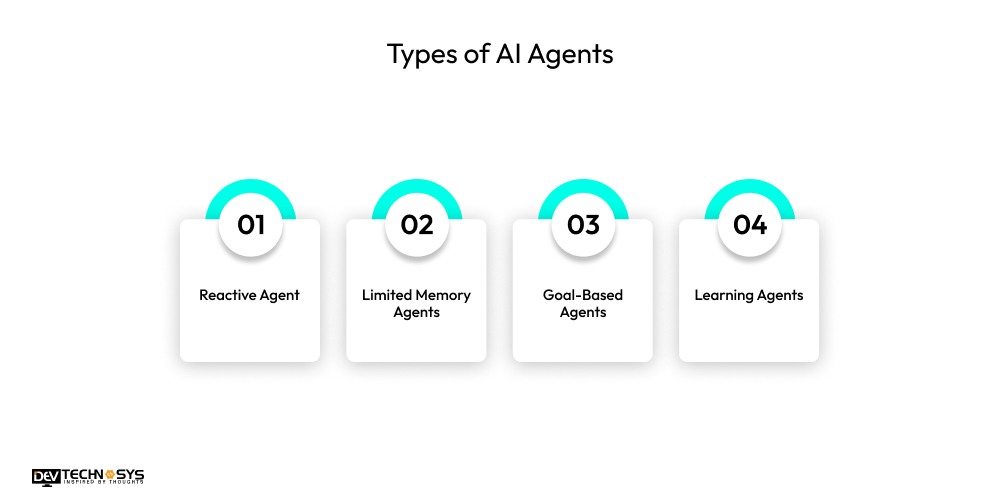
1. Reactive Agents
These agents act on the basis of predefined rules and do not store any past experiences. They act according to the provided input in real time but cannot learn or improve over time. Since they lack recollection, they are generally faster and more efficient, a perfect solution for simple, rule-based tasks.
Example: Basic robot vacuum cleaner that changes direction when it hits an obstacle but doesn’t remember room layout.
2. Limited Memory Agents
If you want to know how to create an AI agent with ChatGPT, then you need to learn more about limited memory agents. To improve the data-driven decision-making process, these agents retain past data for a short duration.
They make adjustments based on recent inputs but do not continuously evolve over long-term experiences. According to experts at a top AI consulting company, many AI systems today fall into this category since they combine real-time reactions with short-term learning.
Example: ChatGPT that remembers context within a session to provide coherent responses but doesn’t retain long-term memory between sessions.
3. Goal-Based Agents
These agents don’t just react but evaluate multiple possible actions before making a decision. They use search algorithms and decision trees to determine the best course of action. Unlike limited-memory agents, they actively consider future outcomes rather than just past interactions.
Example: Navigation Systems like Google Maps calculate multiple routes and suggest the most efficient path.
4. Learning Agents
Businesses who want to know how to build an agentic AI should learn about these agents. Learning agents like Agentic AI use machine learning and deep learning to continuously improve based on experience.
They incorporate reinforcement learning, meaning they get better with feedback over time. Unlike limited-memory agents, they store large datasets and use past experiences to refine decision-making.
Example: Netflix’s Recommendation System that analyzes your viewing history to personalize suggestions.
Interested in a chatbot demo, pricing, or more info? Fill out the form our expert will contact you shortly.
-
Chatbot Demo
-
Cost to Develop an app
-
Industry Report
-
Case Study
Steps to Develop an AI Agent From Scratch
This process involves various important steps, from defining the agent’s purpose to deploying it in a real-world setting. The following outlines the core stages involved in creating your own AI agent.
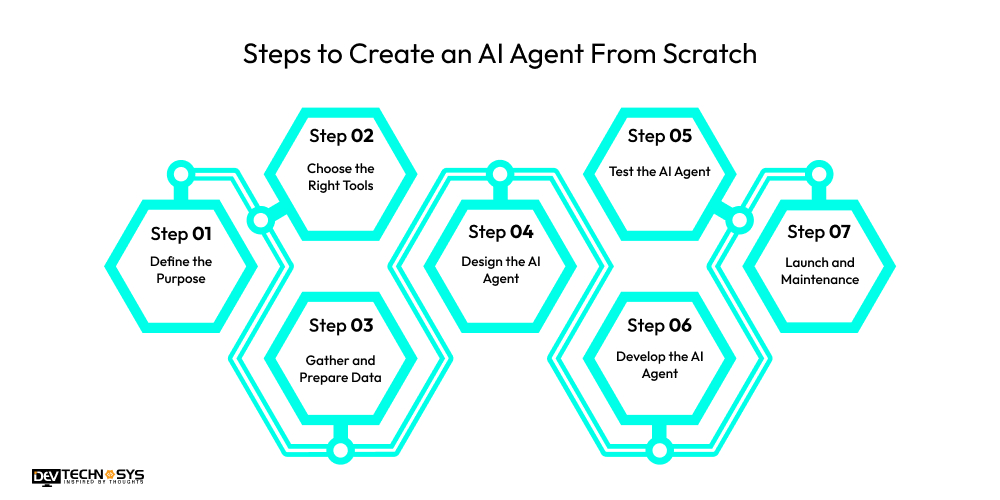
Step 1: State the Purpose of Your AI Agent
Before diving into development, clearly state the goal of your AI agent. What kind of AI agent you want to make, a chatbot, a recommendation system, a virtual assistant, or an automation tool? Defining the use case, user needs, and expected outcomes helps starting strong from the beginning.
This could range from automating customer support and personalizing shopping experiences to managing emails and controlling IoT devices.
Ask yourself:
- Who are the users?
- What decisions or actions should the agent take?
- What kind of data will it need?
- This helps shape all future decisions around design, technology, and training.
Step 2: Select the Right Tools and Frameworks
Now that we have a clear purpose for our AI agent, the next step is choosing a programming language, frameworks, and libraries that meets your goals and requirements. Your choice will depend on your AI agent’s goal.
i. Programming Languages:
- Python – Ideal for AI/ML projects due to extensive libraries and ease of use.
- JavaScript – Useful if you’re integrating AI into web apps.
- Java / C++ – High-performance apps, like gaming AI or embedded agents.
ii. AI Libraries/Frameworks:
- TensorFlow / PyTorch – For building and training neural networks.
- Scikit-learn – For implementing machine learning algorithms like regression, SVM, clustering, etc.
- OpenAI Gym – For reinforcement learning environments.
iii. NLP Tools:
- spaCy, NLTK – For tokenization, POS tagging, named entity recognition, etc.
- Hugging Face Transformers – Pre-trained models like BERT, GPT, and Roberta for advanced NLP tasks.
- Dialog Flow / Rasa / Wit.ai – For conversational agents.
iv. Web/Cloud Integration Tools:
- Flask/Django/FastAPI – For creating REST APIs to connect your AI logic to web apps or mobile platforms.
- React.js / Vue.js – For building a frontend UI to interact with the AI agent.
- Firebase / AWS Lex / Azure Bot Service – Cloud-hosted options for scalability and voice/text handling.
Step 3: Gather and Prepare Data
Gathering the relevant data and information awaits you in this step. In this stage developers collect all qualitative and quantitative data to boost your project’s initial preparation process. Here’s how to approach it:
i. Identify Data Sources:
Start by gathering data from internal systems like CRM, ERP, or spreadsheets, as well as external sources including customer feedback, surveys, or industry reports.
ii. Collect Qualitative Insights:
Talk to stakeholders such as customers, team members, or suppliers. These insights offer more context to the numbers, helping you understand why certain outcomes occur.
iii. Gather Quantitative Data:
Look for measurable metrics like sales numbers, response times, or production rates. These help pinpoint where stoppages or lacks that may occur.
iv. Ensure Data Accuracy:
Make sure that your data is up-to-date and reliable. Outdated or incomplete information can lead to flawed insights.
By collecting the right data, you’ll be equipped to identify critical areas of improvement, which will guide the design of your future process improvements.
Step 4: Design the AI Agent
Now that you have an idea about the problem, the AI agent will solve and have set clear objectives, it’s time to design the agent itself. This step deals with creating a blueprint for how the AI will function, including the architecture, algorithms, and user experience. Here’s the breakdown of what you need to do:
i. Design the architecture and workflows:
- Decide Agent Type: Reactive, goal-based, learning, or utility-based.
- Determine Components: Perception module, memory, decision engine, communication layer.
- Interaction Flow: How will the user engage? Text, voice, GUI, or sensors?
ii. Map out:
- Input ➝ Processing ➝ Output pipeline
- APIs and databases it must connect to
- Required integration with hardware (e.g., smart speakers, robots)
- Also, define how the agent maintains context or learns over time (stateful design).
Step 5: Develop the AI Agent
This stage will introduce you to the core of AI-driven on demand app development solutions and their management: making a successful AI agent itself. This involves the creation of an intelligent, automated system capable of handling IT incidents swiftly and accurately, minimizing human intervention, and ultimately reducing downtime. The core development phase includes:
- Training ML/NLP models or developing rule-based engines
- Writing logic for decision-making and goal-achievement
- Creating fallback mechanisms or escalation logic (especially in chatbots)
- Integrating frontend/back-end components using REST APIs or WebSocket
If you’re building a multi-agent system, also handle agent communication and coordination protocols. For that, you can use:
- Docker for environment consistency
- Git/GitHub for version control
- CI/CD pipelines for smooth deployment
Step 6: Test the AI Agent
No AI agent is perfect out of the gate. You must test its performance in a controlled environment before full deployment:
i. Simulated Incident Testing:
Feed the AI simulated incidents to see how it handles them and measure its ability to classify, prioritize, and resolve them.
ii. Human-in-the-Loop (HITL) Testing:
During initial deployment, allow human technicians to review and intervene when the AI escalates incidents to them. This feedback loop can offer fine-tune the system.
iii. Continuous Learning:
with addition of new data in and more incidents are resolved, ensure the AI agent can take a lesson from each case, enhancing its accuracy and performance over time.
Step 7: Launch and Maintenance
In the last stage to create an AI app, once the AI agent is live, continual monitoring is crucial to ensure it performs well and adapts to new challenges:
- Deploy it on the desired platform like mobile, web, edge, or cloud.
- Monitor performance with tools like Prometheus, Grafana, or Firebase Analytics.
- Regularly provide model updates, adding new data to enhance accuracy and relevance.
- Maintain security patches and ensure compliance with data protection laws such as GDPR and HIPAA.
- Consider a feedback loop where user input or behavior helps the agent evolve over time.
Why Should Businesses Invest in AI Agent Development?
Businesses should invest in AI agent development to reduce expenses, and gain a competitive edge while providing better user experience. Here are the reasons why developing an AI agent is a lucrative deal for businesses:
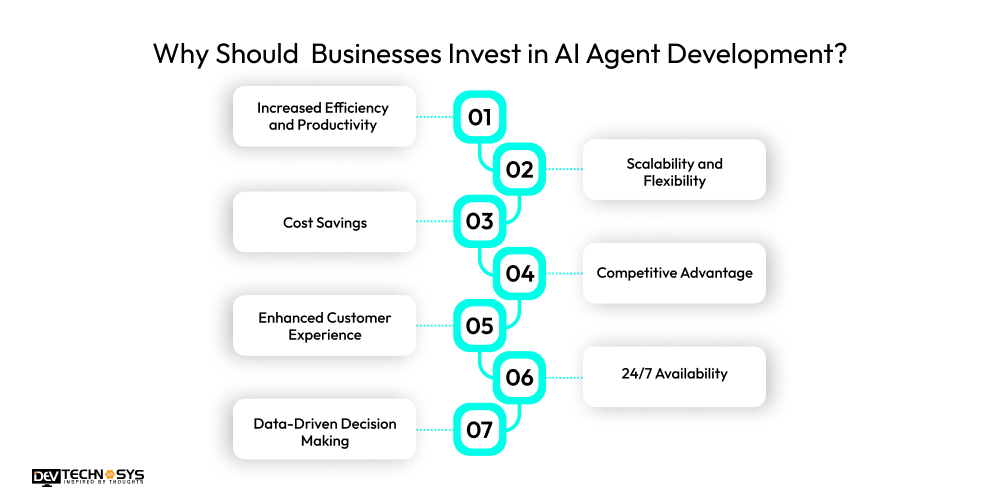
1. Increased Efficiency and Productivity:
AI agents can make routine easier through automation including rule-based tasks such as scheduling, email responses, data entry, and customer support. It frees up human employees for more creative and creative work.
This streamlines operations and boosts overall workforce productivity. For example, to handle thousands of customer queries simultaneously without fatigue, you might need an AI-powered agent that ensures the smooth sailing of your business.
2. Scalability and Flexibility
Unlike human teams, AI agents can scale on demand to handle large numbers of users and data simultaneously without significantly increasing operational costs. Whether it’s managing seasonal rise in demands in customer service or real-time processing of data, these agents provide high flexibility and responsiveness that supports business growth across regions and time zones.
3. Cost Savings
AI agents eliminate or reduce the need for large customer service or functional teams, lower salary, training, and overhead costs. They also reduce the chances of human error, leading to fewer big mistakes that could lead to bigger consequences.
Over time, the investment in AI development pays off through reduced operational costs, getting better resources, and enhanced return on investment (ROI).
4. Competitive Advantage
businesses who utilize AI agents early have more chances of being successful than their competitors. Thanks to insights that AI-agent’s faster and smarter business decisions, while automation ensures quicker turnaround times.
By integrating AI across sales, logistics, marketing and promotion, and customer support, businesses can outpace competitors with enhanced speed, personalization, and innovation.
5. Enhanced Customer Experience
AI agents can enhance your experience with fast, accurate, and personalized customer service. They include chatbots that resolve issues in seconds to AI systems that recommend products based on behavior and preferences, so customers feel more valued and understood. This increases engagement, retention, and brand loyalty—key metrics for sustainable growth.
6. 24/7 Availability and Global Reach
One of the major reasons for investing in AI agent development is 24/7 availability. AI agents can work round-the-clock without breaks or downtime, offering services across different time zones.
This is highly beneficial for businesses with global customers who expect instant responses at any hour. An AI agent doesn’t need sleep—it can serve customers anytime, anywhere.
7. Data-Driven Decision Making
AI agents collect and analyze in vast amounts and in real time, offering valuable insights. These insights support better predictions, customer segmentation, inventory management, and strategies for personalization. With AI, businesses make decisions that are proactive, not reactive.
Features Required to Build An AI Agent
Here are some of the essential features you need to incorporate while making an AI agent.
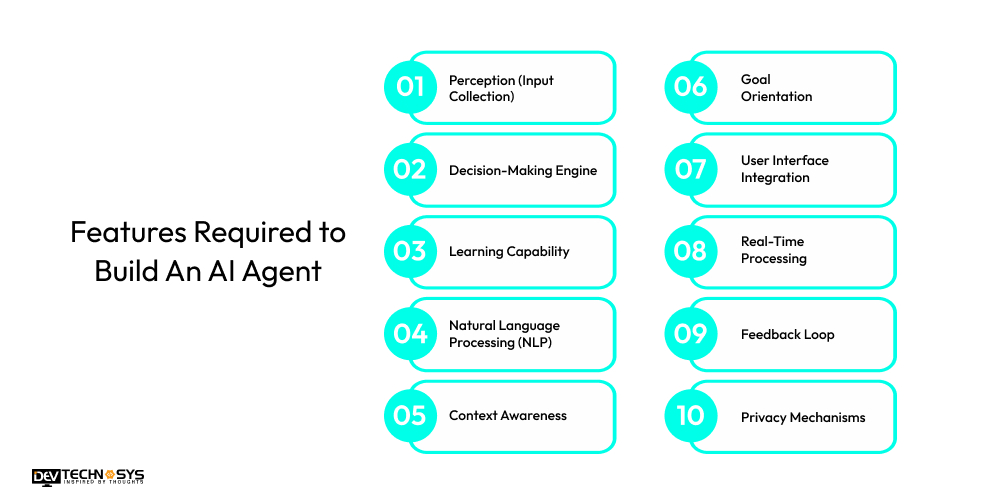
-
Perception (Input Collection)
An AI agent should be able to observe its environment through sensors, data inputs, or user interaction. This includes speech recognition, visual detection, or data ingestion from APIs and sensors.
-
Decision-Making Engine
A core feature where the agents process data that users input, evaluates conditions and gives out most appropriate action. This logic is typically controlled by rules, goals, or machine learning algorithms.
-
Learning Capability
Modern AI agents must learn from past data or experiences to improve performance as time passes. This may involve machine learning, whether it’s supervised or unsupervised, reinforcement learning, or learning mechanisms.
-
Natural Language Processing (NLP)
According to companies providing natural language processing services, NLP is a crucial concept for training AI agents. To interact with users effectively, especially in voice or text-based agents, NLP is required for understanding, interpreting, and generating human language. Tools like BERT, GPT, or spaCy are commonly used.
-
Context Awareness
AI agents need to maintain short-term or long-term memory to understand context, user history, or previous interactions. This helps improve response relevance and continuity in tasks.
-
Goal Orientation
A good AI agent should be able to define or be assigned goals and work toward achieving them using intelligent planning or optimization strategies. Goal-setting drives the agent’s behavior.
-
User Interface Integration
AI agents should seamlessly integrate with frontend systems like web apps, mobile apps, or voice assistants to interact with users through a user-friendly, simple, and intuitive interface.
-
Real-Time Processing
Timely responses are critical. AI agents should be capable of processing information and making decisions quickly, especially in areas like healthcare, customer service, or self-driving vehicles.
-
Feedback Loop
AI agents must be able to gather feedback (explicit or implicit) from users or system outcomes to adjust their actions or improve their models. This enhances learning and performance over time.
-
Security and Privacy Mechanisms
Since AI agents handle sensitive data, they must be built with strong encryption, access controls, and following data privacy regulations such as GDPR or HIPAA.
What is The Cost to Build an AI Agent?
The cost to build an AI agent differs on the basis of complexity and features. Basic recommendation systems can begin from $5,000, while advanced systems with more functionalities can range between $10,000 to $15,000. The cost and complexity can also be influenced by choice between filtering through collabs, content-based filtering, or hybrid models.
Custom-built chatbots can range from $15,000 to $30,000, on the basis of complexity. Pre-built ai agent solutions may cost between $20 to $500 per month, depending on features and usage. The cost to develop an AI agent can significantly impact the overall budget.
AI Agent Level |
Estimated Cost (USD) |
Development Time |
| Simple Reactive Agent | $8,000 – $12,000 | 2 – 4 weeks |
| Limited Memory Agent | $12,000 – $18,000 | 4 – 6 weeks |
| Goal-Based Agent | $15,000 – $22,000 | 6 – 8 weeks |
| Learning Agent | $20,000 – $25,000+ | 8 – 12 weeks |
Factors Impacting The Cost to Build an AI Agent
Here are the key factors impacting the AI agent development Cost, each explained in 2–3 lines to give a clear understanding of what influences pricing:
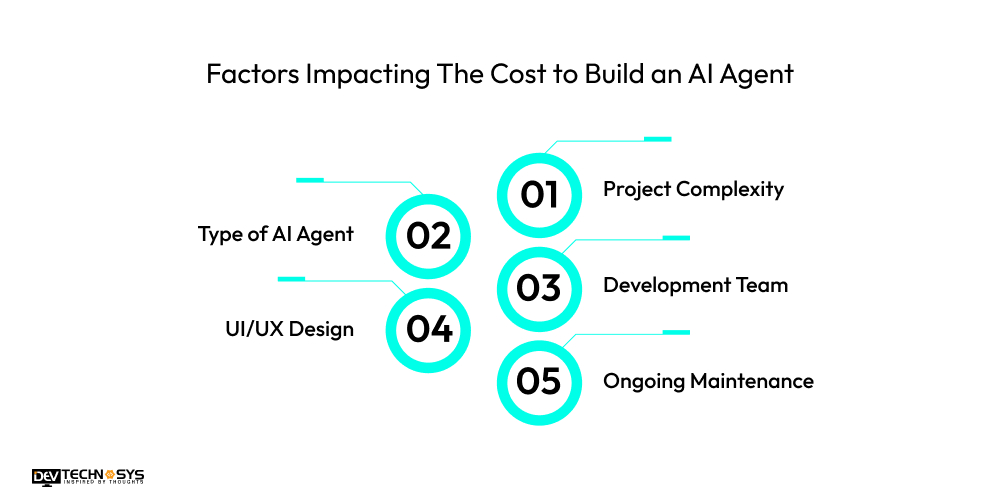
1. Project Complexity
According to experts at the top AI development companies who create AI agents, The more advanced your AI agent is, the more development time, tools, and expertise it requires, which directly increases the AI agent development cost.
Complexity Level |
Estimated Cost (USD) |
Development Time |
| Basic (Single Function) | $8,000 – $12,000 | 2 – 4 weeks |
| Medium (Multi-feature) | $13,000 – $20,000 | 4 – 6 weeks |
| High (Custom Logic & NLP) | $21,000 – $30,000 | 6 – 10 weeks |
2. Type of AI Agent
The cost to develop an AI agent can also be impacted by the type of agent you choose. Reactive agents are simpler and cheaper while learning agents or multi-agent systems with NLP or vision capabilities can significantly raise costs due to sophisticated algorithms and larger datasets.
AI Agent Type |
Estimated Cost (USD) |
Development Time |
| Reactive Agent | $8,000 – $12,000 | 2 – 3 weeks |
| Limited Memory Agent | $13,000 – $18,000 | 4 – 6 weeks |
| Goal-Based Agent | $16,000 – $22,000 | 5 – 7 weeks |
| Learning Agent | $20,000 – $30,000 | 6 – 10 weeks |
3. Development Team & Location
Hiring AI agent developers from North America or Western Europe is comparatively costlier than outsourcing to countries like India or Eastern Europe. The cost to build an AI agent can start from $20/hour and reach up to $150/hour, depending on region and skill.
Team Type / Location |
Estimated Cost (USD) |
Development Time |
| Freelancers (Asia) | $8,000 – $12,000 | 3 – 5 weeks |
| Offshore Agency (Europe/Asia) | $13,000 – $20,000 | 4 – 7 weeks |
| In-house or US Agency | $22,000 – $30,000 | 6 – 10 weeks |
4. UI/UX Design
Interactive agents, especially those integrated into mobile/web apps or IoT devices, need quality UI/UX design, which adds to the cost depending on the level of customization required. The table below outlines the cost to create an AI agent based on UI/UX design.
Design Quality |
Estimated Cost (USD) |
Development Time |
| Basic Template UI | $1,000 – $2,000 | 1 week |
| Custom UI with Wireframes | $2,500 – $5,000 | 2 – 3 weeks |
| Advanced Interactive UX | $6,000 – $8,000+ | 3 – 4 weeks |
5. Ongoing Maintenance & Training
The cost to build an AI agent can differ depending on maintenance costs. Post-launch support, including model retraining, bug fixes, performance monitoring, and updates that require a long-term budget commitment, typically 15–20% of the initial cost to build Artificial Intelligence project.
Scope |
Annual Cost (USD) |
Services Covered |
| Basic | $1,000 – $3,000 | Bug fixes, monitoring, basic support |
| Standard | $4,000 – $7,000 | AI updates, API fixes, improvements |
| Advanced | $8,000 – $12,000+ | Continuous training, scaling, upgrades |
Monetization Techniques For AI Agents
Here are some of the top monetization techniques that can elevate your business, making it reach new heights. Take a look:
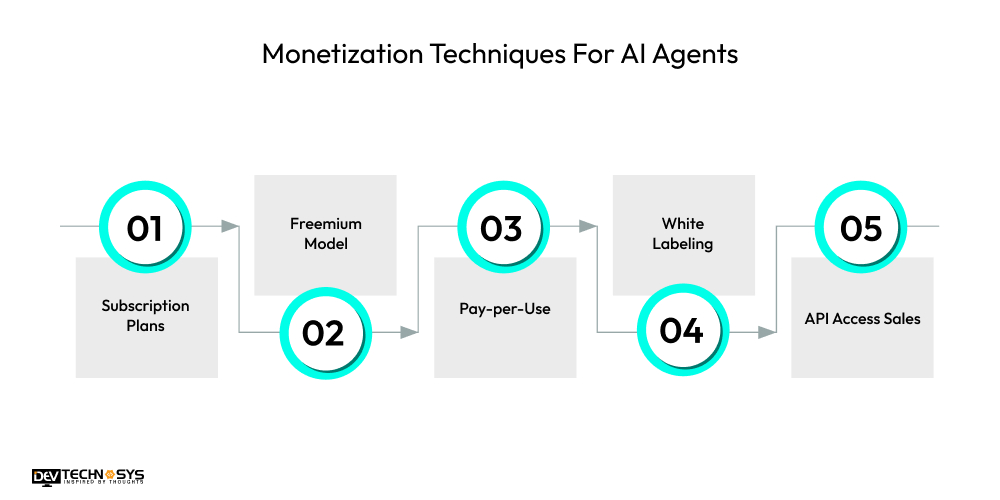
1. Subscription Plans
Through this strategy, companies can charge a monthly or yearly fee for access to your AI agent. This is ideal for SaaS tools, virtual assistants, or B2B AI services. Offer tiered pricing based on features, usage, or support levels.
2. Freemium Model
If you create an mobile app like AI agent, it offer basic features and functions for free and charging a fee for advanced features. This helps attract a large user base while upselling premium tools, such as analytics, integrations, or faster response times.
3. Pay-per-Use (Usage-Based Billing)
Users are charged based on the frequency of their interactions with the AI agent or the number of queries or interactions they process. Common for APIs, customer service bots, and data analysis tools.
4. White Labeling
License your AI agent to other businesses who want to brand and use it as their own. This is common for chatbot frameworks, recommendation engines, or AI assistants in retail and healthcare.
5. API Access Sales
Offer your AI capabilities (e.g., NLP, sentiment analysis, predictions) as an API that developers or companies can integrate into their products, charging per request or via subscription.
Conclusion
We hope the above presented information helps you learn more about AI agent development and clears any doubts you may have regarding the development process, cost, or any other factor. It is not easy to build an AI agent, so we advise you to contact a top mobile application development company such as Dev Technosys for high tech and seamless development.
Our experts provide cutting-edge AI agent development services with advanced features, tools, and technologies. Stay tuned for more informative updates.
FAQs
Q1. Do I Need To Know Programming To Build An AI Agent?
Yes, understanding programming is very helpful when building an AI agent. Python is the most recommended language because it’s easy to learn and offers a wide range of AI development libraries.
Q2.Which Programming Language Is Best For AI Agent Development?
Python is widely considered the best language for AI development because of its simplicity and strong community support. It offers powerful AI libraries like TensorFlow, PyTorch, Keras, and Scikit-learn.
Q3.How Much Data Is Required To Train An AI Agent?
The amount of data you need depends on the type of AI agent you’re building. A simple chatbot may need a few hundred text samples, while a learning agent for image or voice recognition may need thousands or even millions of data points.
Q4.How Long Does It Take To Build An AI Agent?
Time depends on the complexity of the agent. A basic AI agent with limited functions can be developed in 2 to 4 weeks. More advanced agents, especially those using machine learning or deep learning, may take 2 to 6 months to build, test, and deploy fully.
Q5.Can I Use Pre-Built Tools To Create An AI Agent?
Yes, there are many tools and platforms that can help you build AI agents without starting from scratch. For example, Dialogflow, IBM Watson, and Microsoft Bot Framework offer templates for building chatbots.
